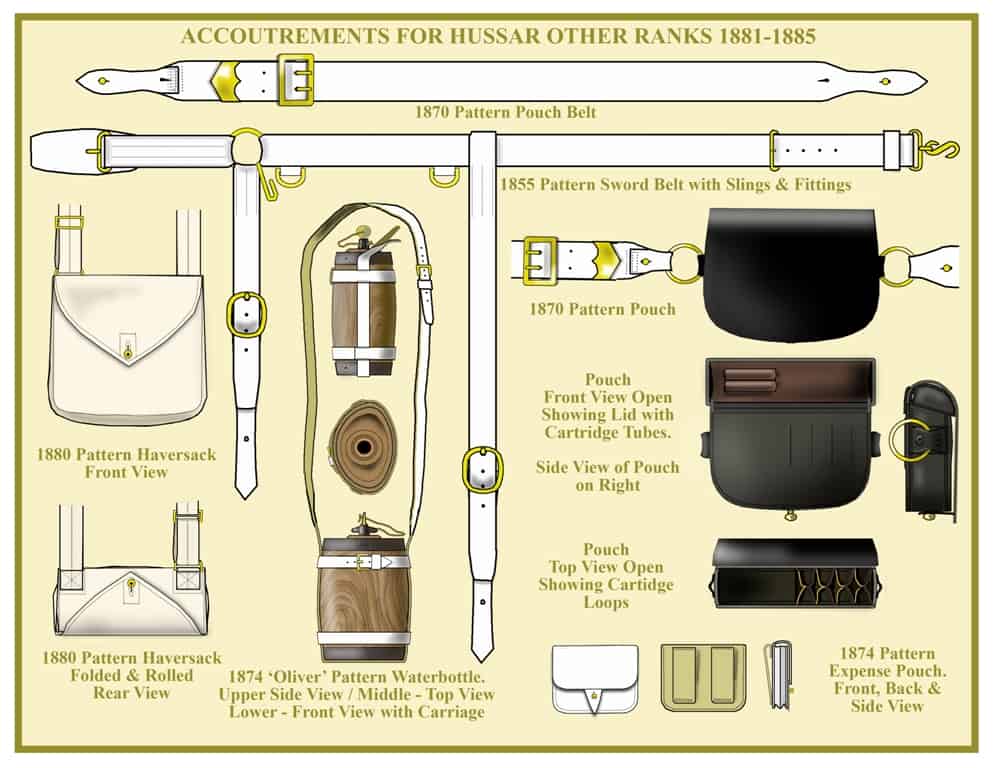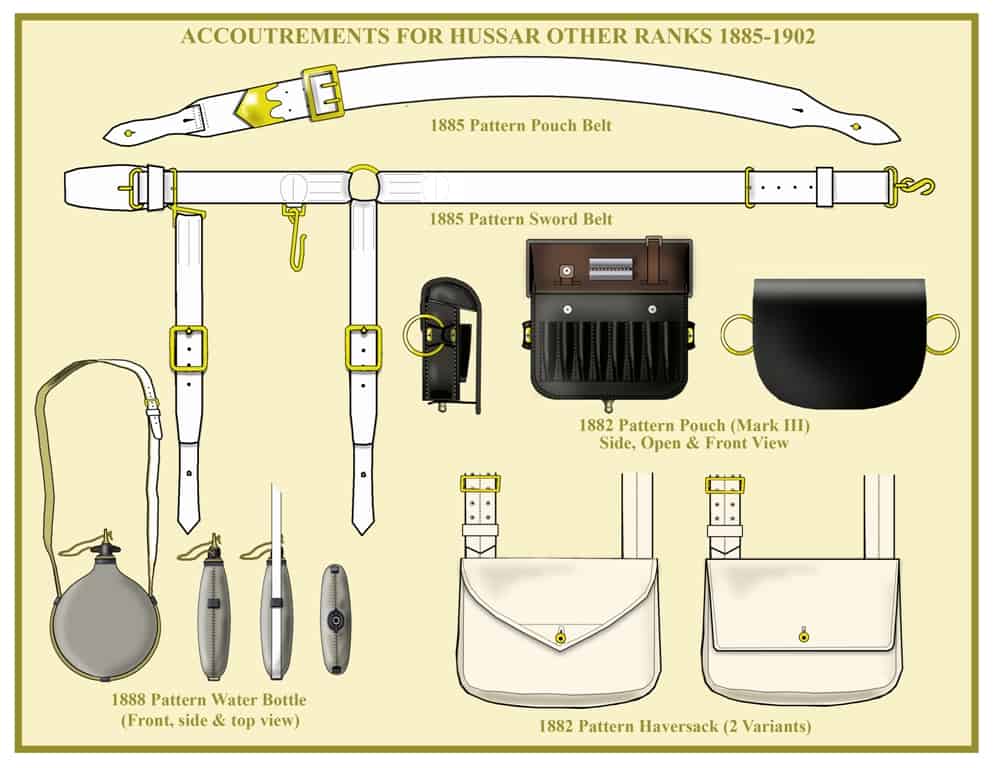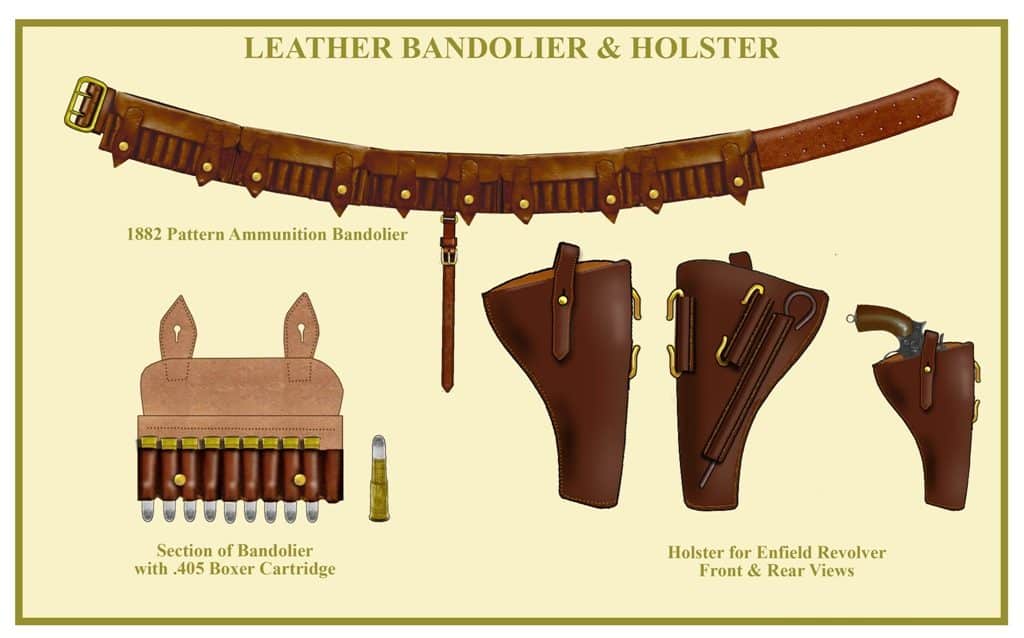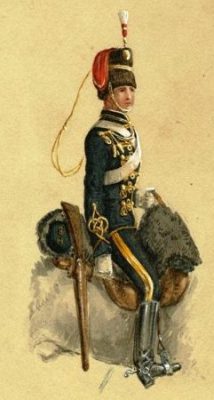OTHER RANKS – PRE 1885
The personal load carrying equipment carried by the cavalryman in the eighteen-seventies was much like that worn during the Napoleonic Wars; a wide shoulder belt with a cartridge pouch on the rear, a haversack for rations and personal kit and a water canteen.
With the advent of the breech loading carbine in the late sixties, the swivel belt attachment disappeared and the introduction of the Martini-Henry in 1877 required reconfiguration of the pouch to accept the ammunition.
British cavalrymen wore the 1857 pattern sword belt and slings with very little modification right through till 1885. In the case of hussars, the belt was worn under the tunic and fitted with two brass loops on the left side because hussars still carried the sabretache until 1888 (NCOs until 1901).
Some senior NCOs retained the 1870 pattern belt and slings as, unlike the other ranks, they wore the sword mounted. Often, the sword scabbard was of the previous pattern. The pouch belt was the 1870 pattern which had been modified in small ways, but essentially the same.
The pouch also dating from 1870 was modified in 1877 to take the .45 Martini ammunition, by removing the Snider cartridge tubes on the front. The 1882 pouch shown in the illustration was virtually the same.
The haversack shown is the 1880 universal pattern for all branches of the army, with a pointed flap replacing the rounded one on the 1867 pattern. Both were worn during the eighteen-eighties.
The water canteen carried was known as the “Oliver” pattern water bottle introduced for the entire army in 1874. It had a wooden body with iron loops and white leather carriage system.
An expense pouch for quick access to Martini ammunition was issued in 1879. This was attached to the pouch belt. Hussars were not known to have worn a device on their pouches

OTHER RANKS – POST 1885
When the rings on the sword scabbard were moved to either side of the mouth to fit on the shoe-case attached to the saddle, the configuration of the sword belt and slings needed to be changed.
This resulted in the 1885 pattern sword belt, which had the same snake clasp on the front but with the rear sling suspended from a ring on the back and the front sling on a moveable brass loop. This was modified slightly in 1888 with more rounded loops.
Also in 1885, the pouch belt became curved to more comfortably carry the pouch. The brass fittings were changed slightly.
The pouch itself went through several modifications to accommodate the changes in ammunition from .45 to .303. This was the 1892 pattern, Marks I& II followed by the Mark III in 1893 which carried 30 rounds of .303 ammunition.
In 1901 the pouch belt and pouch were abolished and the sword belt became an article of equipment worn on full dress ceremonial occasions only.
In 1883 a new pattern general service haversack was authorised which was slightly shallower than the previous version and appeared in types with both rounded and pointed flaps. Needless to say, right up to the late 1890s, both the 1880 and 1883 patterns were carried.
The circular iron pattern water bottle encased in light grey cloth was first issued in 1888 to troops overseas. It was not allowed for home service use until the mid-nineties.
During the Boer War many were covered in khaki felt.

OTHER RANKS LEATHER EQUIPMENT
The introduction of breechloading firearms to the battlefield inevitably led to vast increases in ammunition expenditure.
Bandoliers for extra cartridges soon became necessary and the first made its appearance in 1882. These were at first produced locally and mostly used by mounted infantry but their use by cavalry and other branches soon followed. They were worn by the Camel Corps in the Sudan campaigns and elsewhere.
Domestic use began in about 1891 but they seem to have been restricted to mounted infantry. When the pouch and pouch belt began to be discontinued, especially on field exercises, the bandoliers were taken into use.
Each bandolier carried 50 rounds in four 10 round pouches and two 5 round ones at the curvature of the waist.
The tubes on the bandolier were shortened twice before 1897 (The last pattern produced) to accommodate changes in ammunition and access.
The production of ammunition in 5 round chargers for the Lee-Enfield rifles forced a re-design of the belt from 1901.
The pistol holster for use by other ranks, which by the mid-eighties was senior NCOs and trumpeters plus various orderlies, was an item that survived into the 1930s.
First used to accommodate the Enfield revolver it would take most of the Webley marks from 1898 onward.



